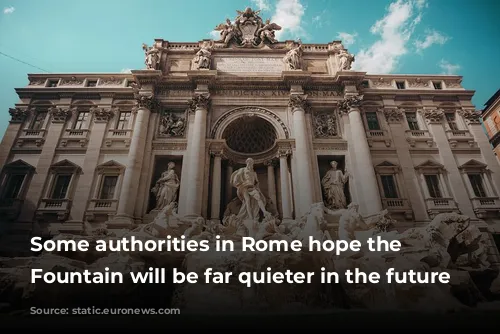Rome, the Eternal City, is grappling with a surge of tourists that’s putting a strain on its iconic landmarks and historical charm.
To address this issue, authorities are exploring ways to manage the influx of visitors while preserving the city’s beauty and heritage. One of the most talked-about proposals involves introducing a ticketing system for the Trevi Fountain, a beloved attraction that’s often overwhelmed by crowds.
A Symbolic Ticket for a Symbolic Landmark
The city’s tourism councilor, Alessandro Onorato, has voiced his support for a limited and timed access system to the Trevi Fountain. This system would involve a free entry for residents of Rome and a symbolic fee of €1 for tourists. The goal isn’t to raise money, but to regulate visitor flow and prevent the fountain from becoming a playground for tourists.
Onorato emphasizes the need for respect for this iconic monument, highlighting the issue of tourists eating and littering around the Trevi Fountain. By controlling the number of visitors and introducing a symbolic fee, authorities hope to create a more respectful environment for everyone.
Managing Tourism: The Trevi Fountain and Beyond
Although the Trevi Fountain ticketing plan is still in its early stages, the initiative reflects Rome’s commitment to finding sustainable solutions for tourism. This commitment is evident in other Italian cities as well.
Venice experimented with a €5 day visitor ticket during peak periods, with mixed results. Florence and Rome are also considering raising the tourist tax for overnight stays in response to the rising number of tourists.
These measures aim to balance the economic benefits of tourism with the preservation of cultural heritage and the well-being of local communities.
Balancing Tourism and Sustainability
Rome faces a unique challenge in managing its tourism. The city draws millions of visitors each year, with a significant increase expected in 2025 due to the Jubilee, a religious event that attracts pilgrims from around the world.
The city is actively seeking ways to manage this influx of visitors, recognizing the need for sustainable tourism. This includes initiatives like limiting the opening of new Bed and Breakfasts and holiday homes in the historic centre. However, current regulations prevent the city from fully controlling the growth of non-hotel accommodations.
A Balancing Act
The proposed ticketing system for the Trevi Fountain and other initiatives aimed at managing tourism in Rome represent a crucial step in ensuring that the city’s cultural heritage is preserved for future generations. The city faces a delicate balance between welcoming tourists and protecting its unique identity.
As Rome navigates the complexities of sustainable tourism, it’s essential to find solutions that benefit both the city and its visitors. The Trevi Fountain ticketing plan, while still in its early stages, could be a key step in achieving this balance.
